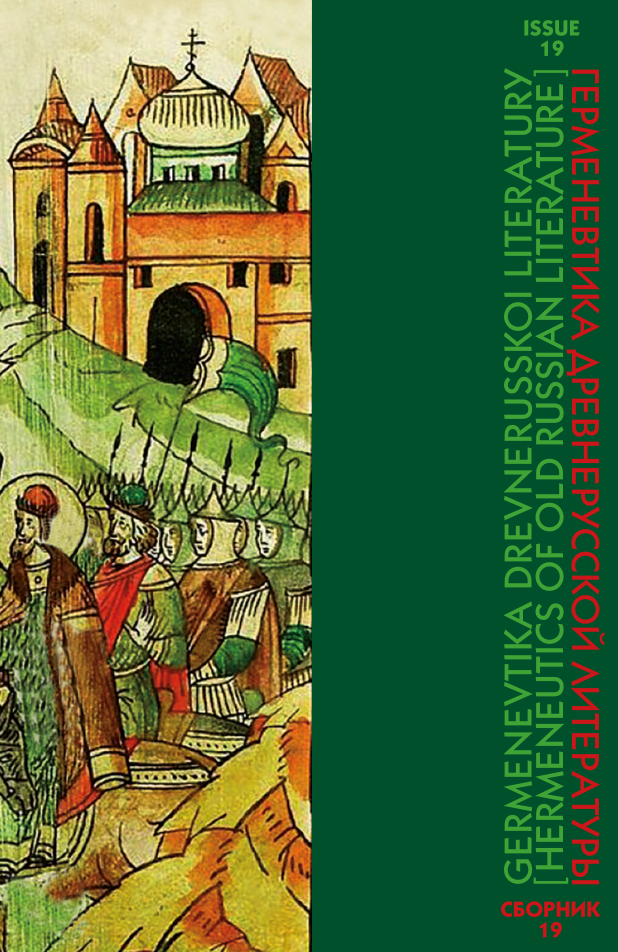Abstract:
The article examines the key motifs in the Vita of the Lithuanian Martyrs Anthony, John and Eustathius. The question of relationship between “hagiographic scheme” and “live content” of Vita, which consists in the uniqueness of saints’ personality and poetics of “nuances” (G.P. Fedotov), is resolved. The leading motifs that determine the content and structure of Vita are the motif of acting like Christ (“imitatio Christi”) and the motif of brotherhood (kinship), which is considered in their connection and mutual influence. The first and main topos of the martyrdom lives “imitatio Christi” is influenced in this hagiography by the second key motif, topos of the brotherhood, which makes up the storyline of brothers Anthony and John. “Imitatio Christi” is the first and main topos in Vita of martyrs. The content of the motif is determined by the opposition of flesh (brotherhood by blood) and Spirit (brotherhood by the faith in Christ). Elder brother John after going through temptation by flesh, fear of suffering and death, agrees to act according to pagan customs outwardly, while maintaining faith internally. But this leads to his falling away from Christ and to Anthony’s rejection of any kinship with him. John’s return to Christ and his way to martyrdom is associated with his kindred love for Anthony, which develops the meaning of brotherhood in the Spirit, while the topos “imitatio Christi” is represented here by its semantic variant — the way of the saint “not following Christ, but towards Him” (T.R. Rudi). The image of Eustathius, adding to and thus “tripling” the holiness of his relatives — martyrs Anthony and John, introduces the idea of Trinity of God, expressed in building the church in the name of Holy Trinity on place of the martyr’s death of his brothers, the saints, which also brings additional meaning to the motif of “imitatio Christi” — men’s service to Trinital God.
REFERENCES
1 Antonova, M.V. “Siuzhetnye toposy v agiografii. Postanovka voprosa” [“Plot Topos in Hagiography. To the Question Statement”]. Vestnik Bryanskogo Gosudarstvennogo Universiteta, no. 2, 2013, pp. 172–175. (In Russian)
2 Zhivov, V.M. Sviatost’. Kratkii slovar’ agiograficheskikh terminov [Holiness. A Brief Dictionary of Hagiographic Terms]. Moscow, Gnozis Publ., 1994. 112 p. (In Russian)
3 Kirillin, V.M. “Simvolika chisel v literature Drevnei Rusi (XI–XVI veka)” [“Symbolism of Numbers in the Literature of Old Rus’ (11th–16th Centuries)”]. Kul’turologiia, no. 4 (20), 2001, pp. 161–166. (In Russian)
4 Loparev, Chr.M. “Vizantiiskie zhitiia sviatykh VIII—IX vv.” [“Byzantine Lives of Saints of 8th–9th Centuries”]. Vizantiiskii vremennik [Byzantine Times], vol. 18, part. 1. St. Petersburg, K.L. Rikker Publ., 1911, pp. 1–147. (In Russian)
5 Ogitskii, D.P. “K istorii vilenskikh muchenikov” [“On the History of Vilnius Martyrs”]. Bogoslovskie trudy [Theological Works], issue 25, 1984, pp. 226–246. (In Russian)
6 Rudi, T.R. “Topika russkikh zhitii (voprosy tipologii)” [“Topics of Russian Hagiographies (Typology Issues)”]. Russkaia agiografiia. Issledovaniia. Publikatsii. Polemika [Russian Hagiography. Investigations. Publishing. Controversy]. St. Petersburg, Dmitrii Bulanin Publ., 2005, pp. 59–101. (In Russian)
7 Rudi, T.R. “‘Imitatio angeli’ (problemy tipologii agiograficheskoi topiki)” [“‘Imitatio angeli’ (Problems of Typology of Hagiographic Topic)”]. Russkaia literatura, no. 2, 2003, pp. 48–59. (In Russian)
8 Speranskii, N.M. “Serbskoe zhitie litovskikh muchenikov” [“The Serbian Life of Lithuanian Martyrs”]. Chteniia v Imperatorskom obshchestve istorii i drevnostei Rossiiskikh pri Moskovskom universitete Materialy istoriko-literaturnye [Readings at the Imperial Society of Russian History and Antiquities 1909. Historical and Literary Materials], part II, pp. 1–48. (In Russian)
9 Fedotov, G.P. Sviatye Drevnei Rusi [Saints of Old Russia]. Moscow, Moskovskii rabochii Publ., 1990, 269 p. (In Russian)
10 Baronas, Darius. Trys Vilniaus kankiniai: gyvenimas ir istorija. Vilnius, Aidai, 2000. 383 p. (In Lithuanian)






